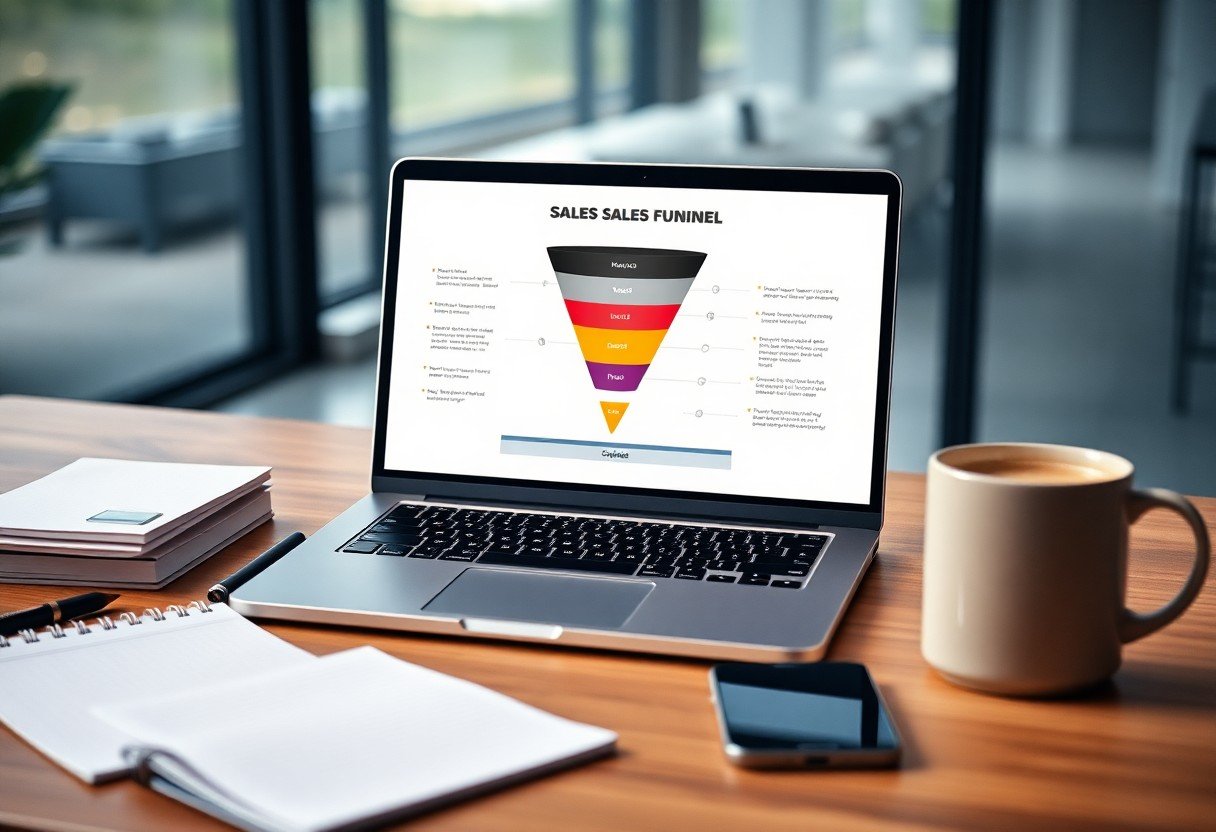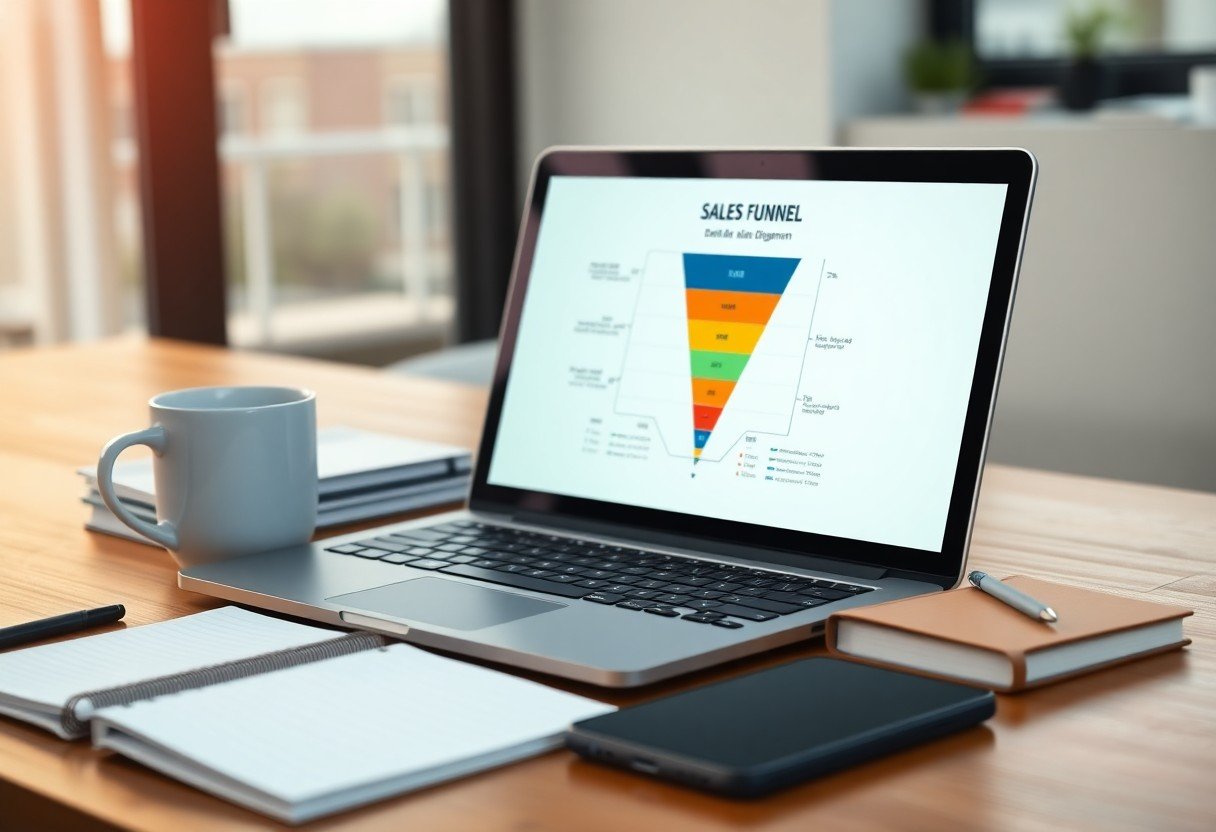With high-ticket sales requiring more trust and nurturing than standard offerings, your funnel needs a strategic approach to convert premium prospects. Your potential clients need to see clear value before investing thousands in your product or service. This comprehensive guide will walk you through building a conversion-optimized sales funnel specifically designed for high-ticket items, from mapping out your customer journey to implementing proven psychological triggers that drive big-ticket purchases. You’ll discover how to position your premium offering and create a seamless path to conversion.
Key Takeaways:
- Value-First Approach – Lead with educational content and genuine solutions before pitching premium offerings to establish trust and authority
- Qualification Process – Implement strict screening methods to identify ideal prospects who can afford and benefit from high-ticket offerings
- Multiple Touchpoints – Create 5-7 meaningful interactions through various channels before making the high-ticket offer to nurture relationships
- Premium Positioning – Develop exclusive content and personalized experiences that justify higher price points and demonstrate superior value
- Follow-up System – Design automated yet personalized follow-up sequences to maintain engagement and guide prospects through each funnel stage
High-Ticket Sales Funnel Foundation
While creating a successful high-ticket sales funnel requires careful planning and strategic implementation, your foundation must be rock-solid from the start. Your high-ticket funnel differs significantly from traditional sales funnels, as it focuses on premium offerings typically priced at $2,000 or above, requiring a more sophisticated approach to lead nurturing and conversion.
Quick recommendation: Our blog is filled with useful tips to help you succeed. If you are seeking a more comprehensive training program, we recommend the 72 Hour Challenge.
Defining Your Premium Offer
Along with establishing your funnel’s structure, you need to craft a premium offer that delivers exceptional value and justifies its high price point. Your high-ticket offer should solve significant problems or fulfill ambitious aspirations for your target market, incorporating unique elements such as personalized consulting, done-for-you services, or exclusive access to resources that set you apart from lower-priced alternatives.
Identifying Ideal High-Value Clients
Along with your premium offer development, you must precisely define your ideal high-value client profile. Your target audience for high-ticket sales typically consists of successful professionals, established business owners, or organizations with substantial budgets. Research shows that high-ticket buyers often spend 3-4 times more time in the consideration phase compared to standard purchases.
The process of identifying your ideal clients involves analyzing key demographics, psychographics, and behavioral patterns. You should focus on prospects who not only have the financial capacity but also demonstrate a genuine need for your premium solution, with studies indicating that 65% of high-ticket buyers prioritize value and results over price considerations.

Lead Generation Mechanisms
Even the most compelling high-ticket offer needs a steady stream of qualified prospects to succeed. Your lead generation mechanisms should focus on attracting prospects who have both the means and inclination to invest in premium solutions. Research shows that 68% of successful high-ticket sales funnels incorporate multiple lead capture methods, allowing you to cast a wider net while maintaining quality.
Premium Lead Magnets
Before you start driving traffic to your funnel, you need to create lead magnets that match the value of your high-ticket offer. Your premium lead magnets should demonstrate expertise and provide substantial value – think comprehensive white papers, in-depth case studies, or exclusive video training series. Data indicates that detailed industry reports and expert guides convert at 2-3 times the rate of basic downloadable PDFs.
Authority-Building Content Strategy
Magnets alone won’t establish you as an industry leader – you need a robust content strategy that positions you as the go-to expert in your field. Your strategy should include a mix of thought leadership articles, expert interviews, and data-driven insights. Studies show that businesses implementing consistent authority-building content strategies see a 47% higher conversion rate in their high-ticket funnels.
Plus, your authority-building content needs to align with your target audience’s specific pain points and aspirations. You can enhance your content strategy by incorporating client success stories, industry trend analysis, and expert roundups. This approach helps you build trust and credibility while moving prospects through your sales funnel – statistics reveal that 73% of high-ticket buyers consume at least 3-5 pieces of authoritative content before making a purchasing decision.
Nurturing Sequence Design
Now that you’ve captured your prospects’ attention, it’s time to develop a nurturing sequence that guides them toward your high-ticket offer. Your nurturing sequence serves as the bridge between initial interest and purchase decision, typically requiring 7-12 touchpoints before a high-ticket sale converts. This strategic communication flow helps you build trust, demonstrate expertise, and position your premium offering as the ideal solution.
Email Marketing Architecture
Across your email sequence, you’ll need to structure your communications to maintain engagement while steadily building value. Your email architecture should follow a proven 3-2-1 format: three valuable content pieces, two case studies or social proof elements, and one direct offer. This approach has shown to increase conversion rates by up to 27% for high-ticket items above $3,000.
Quick recommendation: Our blog is filled with useful tips to help you succeed. If you are seeking a more comprehensive training program, we recommend the 72 Hour Challenge.
Value-Based Content Delivery
By focusing on delivering substantial value before making your offer, you establish yourself as an authority in your field. Your content should address specific pain points and showcase solutions through a mix of formats – from detailed how-to guides to expert interviews and industry insights. Research shows that prospects who engage with at least 3 pieces of value-based content are 4 times more likely to convert on high-ticket offers.
But it’s not just about the quantity of content – the quality and strategic placement matter significantly. You should structure your value delivery to create progressive insights, where each piece builds upon the previous one, creating a logical path to your high-ticket solution. This approach helps prospects understand the full scope of their challenges and positions your premium offering as the comprehensive solution they need.
Sales Conversion Process
After qualifying your leads through your marketing funnel, you’ll need a well-structured sales conversion process to turn prospects into high-ticket clients. Your process should include clear steps from initial contact to closing, with specific touchpoints designed to build trust and demonstrate value. Research shows that businesses with a defined sales process experience 18% more revenue growth compared to those without one.
Discovery Call Structure
Before plunging into your discovery call, you need to prepare a strategic framework that helps you understand your prospect’s needs while positioning your high-ticket offer as the ideal solution. Your discovery call structure should follow a 70/30 rule – letting the prospect speak 70% of the time while you guide the conversation for the remaining 30%. This approach helps you gather crucial information about their pain points, goals, and budget while building rapport.
Objection Handling Framework
Before presenting your offer, you must develop a comprehensive objection handling framework that addresses common concerns about price, timing, and implementation. Studies indicate that 60% of prospects use price as their primary objection, making it crucial for you to focus on value communication rather than cost justification.
The most effective objection handling framework follows the LAER method (Listen, Acknowledge, Explore, Respond), allowing you to address concerns while maintaining the relationship’s integrity. By implementing this systematic approach, you can increase your closing rate by up to 32% and maintain higher client satisfaction levels throughout the sales process.
Follow-Up Systems
Despite having a well-structured sales funnel, up to 80% of sales require at least five follow-ups before closing. Your follow-up system needs to be systematic, personalized, and consistent to maintain engagement with potential clients throughout their buying journey. By implementing an effective follow-up strategy, you’ll be able to nurture leads, address concerns, and guide prospects toward making high-ticket purchases.
Multi-Channel Approach
At the core of your follow-up system should be a multi-channel communication strategy that meets your prospects where they are. You can leverage email sequences, SMS messaging, social media retargeting, and phone calls to create multiple touchpoints. Research shows that companies using three or more channels in their follow-up campaigns achieve a 287% higher purchase rate compared to single-channel approaches.
Re-engagement Campaigns
Any leads that have gone cold represent untapped potential for your high-ticket sales funnel. Your re-engagement campaigns should focus on rekindling interest through value-packed content, exclusive offers, and personalized outreach. Studies indicate that re-engagement campaigns can recover up to 25% of dormant leads when properly executed.
And to maximize the effectiveness of your re-engagement efforts, you’ll want to segment your inactive leads based on their previous interactions, time since last engagement, and position in the sales funnel. This targeted approach allows you to craft messages that specifically address the reasons for their disengagement, whether it’s pricing concerns, timing issues, or need for additional information.
Optimization and Scaling
Many successful high-ticket sales funnels require continuous optimization to maintain and improve their performance. You’ll need to regularly analyze your funnel metrics, test different elements, and make data-driven adjustments to enhance conversion rates. Your optimization efforts should focus on identifying bottlenecks, improving user experience, and refining your messaging to better resonate with your target audience.
Key Performance Metrics
Beside tracking your overall conversion rate, you’ll want to monitor specific metrics at each stage of your funnel. Your cost per lead (CPL), lead-to-sale conversion rate, and average customer lifetime value (CLV) provide valuable insights into your funnel’s effectiveness. According to recent studies, top-performing high-ticket funnels maintain a lead-to-sale conversion rate of 5-10% and achieve a CLV that’s 3-5 times higher than their initial product price.
Traffic Scaling Methods
Before scaling your traffic, you’ll need to ensure your funnel consistently converts at a profitable rate. Your initial focus should be on achieving a positive return on ad spend (ROAS) with a smaller budget before increasing your marketing investment. Studies show that successful high-ticket funnels typically aim for a minimum ROAS of 3:1 before implementing aggressive scaling strategies.
Methods for scaling your traffic effectively include expanding your advertising channels, leveraging lookalike audiences, and implementing retargeting campaigns. You can diversify your traffic sources by combining paid advertising with content marketing, social media outreach, and strategic partnerships. Your scaling strategy should prioritize maintaining quality leads while gradually increasing volume, as data indicates that rapid scaling can often lead to a 20-30% decrease in conversion rates if not managed properly.
Summing up
Following this comprehensive guide to creating a high-ticket sales funnel will position you to effectively convert prospects into premium customers. By implementing each step strategically – from identifying your ideal client and crafting compelling content to nurturing leads and optimizing your follow-up process – you’ll build a robust system that consistently generates high-value sales.
Your success in high-ticket sales depends on your ability to provide exceptional value at every touchpoint while maintaining authentic relationships with your prospects. As you refine your funnel based on performance metrics and customer feedback, you’ll develop a powerful sales machine that not only attracts qualified leads but transforms them into loyal, high-paying clients who champion your brand.
Quick recommendation: Our blog is filled with useful tips to help you succeed. If you are seeking a more comprehensive training program, we recommend the 72 Hour Challenge.

